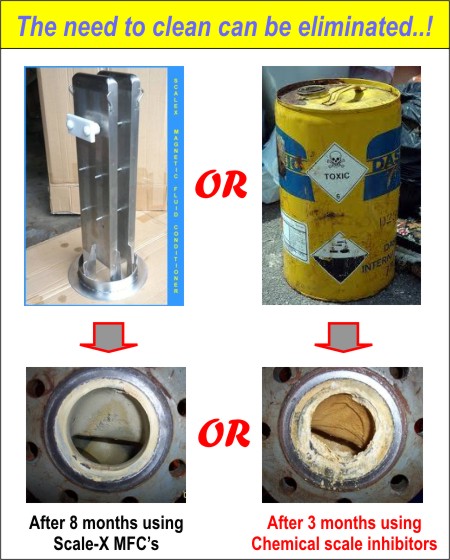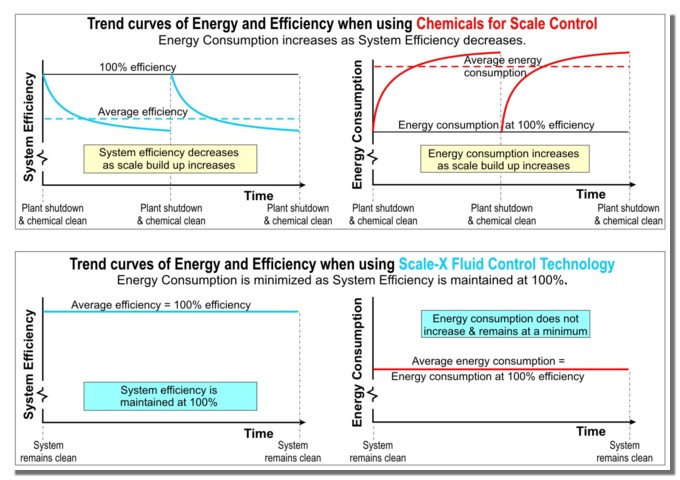|
The following is a comparison of :
●
the benefits of using Scale-X fluid conditioning technology
verses
●
the disadvantages of using chemical dosing.
The
choice of controlling scale problems in water, and
other fluid systems, is between the:-
(1) non-chemical Scale-X fluid conditioning technology which stops scale, biofilm and slime from forming;
and
(2) conventional chemical dosing using environmentally dangerous
and hazardous chemicals which only slows down the rate at which
scale and biofilm (slime) builds up.

|
|
Scale control using Scale-X fluid conditioning technology |
|
|
|
Scale control using the conventional chemical dosing
technology |
|
|
|
Running costs are maintained at a minimum, that is, the
100% efficiency level |
|
|
|
Running costs increase as the scale and bio-film build
up. Costs do increase significantly |
|
|
|
The system operates continuously at 100% efficiency |
|
|
|
The system operates typically at significantly less than
100% efficiency |
|
|
|
Stops scale and bio-film (slime) from forming |
|
|
|
Scale and bio-film (slime) continues to build up and
foul the system |
|
|
|
Eliminates need for regular shutdowns to de-scale and
clean |
|
|
|
Regular shutdowns still required to de-scale and clean
the system |
|
|
|
Chemical inhibitors can be eliminated |
|
|
|
Chemical dosing of inhibitors are essential and are
hazardous compounds for workers to handle |
|
|
|
Scale-X fluid conditioning technology is environmentally safe |
|
|
|
Chemical dosing is hazardous to the environment |
|
It is to be noted that
biofilm (slime):-
●
which is a constant problem when using chemicals and
●
which forms within a
few days after a chemical clean,
can have a greater impact on energy usage than does scale
|
|
Biofilm (slime) increases energy usage up to 4
times faster than does calcium carbonate. |
|
|
|
Some deposits are more insulating than others and thus
have a greater impact on the head pressure and energy
requirements. For example, the biofilm (slime) impact on
energy usage is 4 times worse than the impact of calcium
carbonate and lime scales. Also it is important to
note that biofilm deposits much faster than scale does.
|
|
|
|
As a result, biofilm (slime) increases head pressure and
will shut down a chiller much
faster than will “normal” (calcium carbonate and lime) scales,
as well as having a much greater impact on energy usage. |
|
|
|
HVAC Energy Conservation |
|
|
|
Through Cooling Water Treatment |
|
|
|
By: . Bhatia |
|
|
|
Continuing Education and Development Inc |
|
|
|
Stony Point, NY 10980 USA |
|
|
|
|
|
Scale-X fluid conditioning
technology saves running costs by minimising energy usage:-
Because Scale-X fluid conditioning technology stops scale and biofilm from
forming, the system then runs at 100% efficiency and minimises
energy usage. The
following is a comparison of running costs for Scale-X verses
conventional chemical technology:-
|
Using Scale-X fluid conditioning technology |
Average reduction in efficiency |
Increase in energy usage & Increase in running costs |
|
System remains clean continuously |
0% |
0% |
|
|
|
|
|
Using a chemical dosing & Chemical cleaning regime |
Average reduction in efficiency |
Increase in energy usage & Increase in running costs |
|
Very well maintained system |
10 to 12% |
11 to 14% |
|
Typically maintained system |
15 to 25% |
18 to 33% |
|
Poorly maintained system |
30 to 50% |
43 to 100% |
The following shows
graphically why Scale-X saves running costs. Note the
trend lines of both efficiency and energy usage:-

Enlarge to view the trend curves for Energy and Efficiency for
Scale-X MFCs verses Chemical dosing.

|